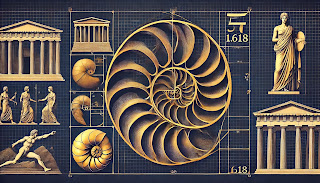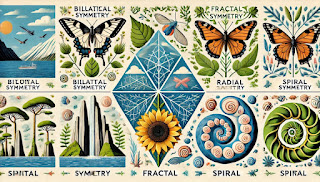Introduction
Nature is a masterpiece of design, exhibiting intricate patterns that span from microscopic structures to vast celestial formations. These patterns are not coincidental; they arise from underlying mathematical principles and physical laws that govern the natural world. From the spirals of galaxies to the self-similarity of fractals, nature’s architecture reveals an inherent order that scientists, engineers, and artists seek to understand and replicate.
By studying these patterns, we gain insights into biological growth, structural efficiency, and even human perception of beauty. Whether in plant formations, geological structures, or animal behavior, nature’s designs influence technology, architecture, and even medicine. This article explores the science behind nature’s most mesmerizing patterns and their profound impact on the world around us.
 |
Fractal Flower: Self-Replicating Patterns in Nature |
The Mathematics Behind Natural Patterns
The Fibonacci Sequence and Golden Ratio
A fundamental pattern in nature is the Fibonacci sequence, a numerical series where each term is the sum of the two preceding ones (1, 1, 2, 3, 5, 8, 13, and so on). This sequence manifests in various natural phenomena, including:
The spiral arrangement of sunflower seeds and pinecones
The branching of trees and root systems
The whorled structure of galaxies and hurricanes
The organization of flower petals and seed distributions
The geometry of mollusk shells
Closely related to the Fibonacci sequence is the Golden Ratio (φ ≈ 1.618), a proportion that frequently appears in:
The growth patterns of nautilus shells and spiral galaxies
The facial symmetry of humans and other animals
The proportions of famous artworks and architectural masterpieces
The structural organization of DNA molecules
Both mathematicians and artists recognize the Golden Ratio as a key component of aesthetic harmony and natural efficiency.
 |
| Fibonacci sequence |
Symmetry in Nature
The Role of Symmetry in Biological and Physical Systems
Symmetry is a crucial element in both biological evolution and physical structures. It optimizes energy efficiency, enhances survival mechanisms, and contributes to aesthetic appeal. Symmetry is commonly categorized into:
Bilateral Symmetry – Found in organisms such as humans, butterflies, and mammals, bilateral symmetry is often associated with evolutionary advantages such as streamlined movement and improved sensory coordination.
Radial Symmetry – Seen in creatures like jellyfish, sea anemones, and certain flowers, radial symmetry provides structural balance and facilitates environmental interactions from multiple directions.
Fractal Symmetry – Present in branching structures like trees, river networks, and lung alveoli, fractal symmetry maximizes resource distribution and surface area efficiency.
Spiral Symmetry – Observed in shells, galaxies, and whirlpools, spiral symmetry emerges from dynamic growth patterns and rotational forces.

Symmetry in nature
Fractals: Self-Replicating Patterns in Nature
What Are Fractals and Why Are They Important?
Fractals are self-similar patterns that repeat at different scales, revealing nature’s recursive complexity. Examples include:
The branching of trees, veins, and river networks
The jagged outlines of mountain ranges and coastlines
The crystalline structure of snowflakes
Lightning formations and cloud structures
Fractal geometry has extensive applications in scientific research, including modeling biological growth, analyzing chaotic systems, and optimizing computer graphics and artificial intelligence..
Patterns in Animal Behavior
Migration, Swarming, and Organizational Patterns
Animal behaviors often exhibit mathematical precision:
Flocking and Swarming – Birds, fish, and insects move in synchronized patterns, optimizing communication and predator evasion.
Foraging and Hunting Routes – Ants, wolves, and bees use complex navigational strategies based on pheromones, magnetic fields, and learned behaviors.
Honeycomb Structures – Bees construct hexagonal honeycombs, maximizing storage efficiency and structural strength.
Seasonal Migration Routes – Birds, whales, and butterflies follow precise migratory paths dictated by celestial navigation and geomagnetic sensitivity.
These behaviors highlight the deep connection between biological instincts and environmental adaptation.
The Science Behind Weather and Natural Phenomena
Atmospheric and Oceanic Patterns
Meteorological and oceanographic systems also follow mathematical laws:
Wave Formation – Governed by wind, gravitational forces, and tidal interactions, ocean waves exhibit predictable oscillatory patterns.
Cloud Dynamics – The fractal-like nature of clouds arises from turbulent airflow and condensation processes.
Cyclonic Systems – Hurricanes and tornadoes follow logarithmic spiral formations, shaped by Coriolis forces and atmospheric pressure gradients.
Understanding these patterns enhances weather prediction models and climate research.
Visual Suggestion: Show satellite imagery of hurricanes with a Fibonacci overlay to highlight their structural symmetry.
Applications of Nature’s Patterns in Human Innovation
Engineering, Architecture, and Design
Nature’s efficiency has inspired numerous human-made innovations:
Architectural Principles – Gothic cathedrals, pyramids, and modern skyscrapers incorporate the Golden Ratio for structural integrity and aesthetic appeal.
Biomimicry in Engineering – Structures such as termite-inspired cooling systems and seashell-based exoskeletons enhance sustainability.
Urban Planning and Traffic Flow – City layouts, road networks, and fluid dynamics mimic natural branching systems to optimize efficiency.
Textile and Fashion Design – Patterns from butterfly wings and leaf veins influence artistic and functional designs.
Technological and Medical Applications
Biological patterns inform scientific advancements:
Artificial Intelligence Algorithms – Swarm intelligence, modeled after bees and birds, improves computational problem-solving.
Biomedical Research – Fractal analysis aids in diagnosing cardiovascular diseases and neurological disorders.
Sustainable Energy Solutions – Wind turbine blade designs mimic whale fin structures for increased efficiency.
Case Study: The Influence of Natural Patterns on Agriculture
Indian Farmer’s Success Through Fibonacci-Based Crop Spacing
David, an agricultural innovator from the U.S., leveraged Fibonacci-based plant spacing to optimize resource distribution and crop yield. By arranging plants in spiral formations, he increased sunlight exposure, minimized soil depletion, and boosted productivity by 30%. His success story exemplifies how biomimicry can enhance sustainable farming practices.
Similar approaches extend to irrigation design, pest control strategies, and soil conservation techniques inspired by natural ecosystems.
Conclusion
Nature’s patterns reveal the intrinsic order underlying life’s complexity. From the symmetry of living organisms to the chaotic beauty of fractals, these principles shape both the natural world and human innovation. Recognizing and applying these patterns fosters advancements in science, technology, and everyday life.
Call to Action
Interested in learning more? Subscribe for updates on the latest discoveries in biomimicry and pattern-based innovations!







0 Comments
Kindly share your views